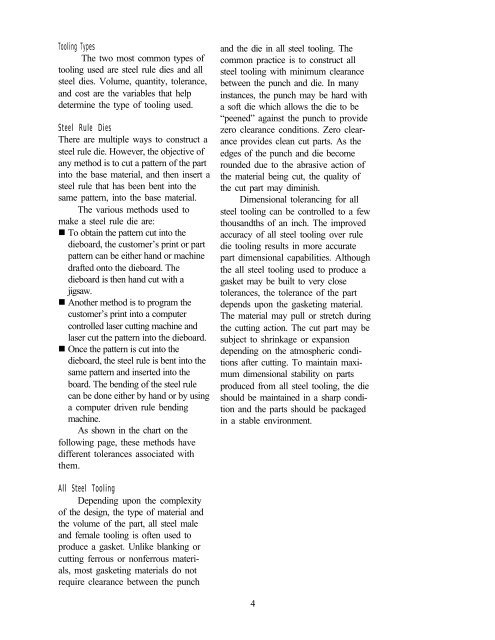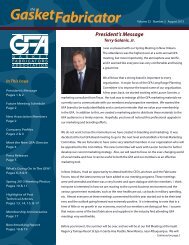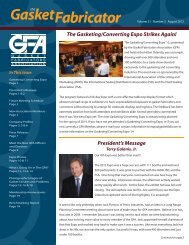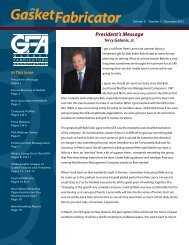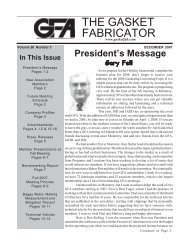Technical Handbook - Gasket Fabricators Association
Technical Handbook - Gasket Fabricators Association
Technical Handbook - Gasket Fabricators Association
Create successful ePaper yourself
Turn your PDF publications into a flip-book with our unique Google optimized e-Paper software.
Tooling Types<br />
The two most common types of<br />
tooling used are steel rule dies and all<br />
steel dies. Volume, quantity, tolerance,<br />
and cost are the variables that help<br />
determine the type of tooling used.<br />
Steel Rule Dies<br />
There are multiple ways to construct a<br />
steel rule die. However, the objective of<br />
any method is to cut a pattern of the part<br />
into the base material, and then insert a<br />
steel rule that has been bent into the<br />
same pattern, into the base material.<br />
The various methods used to<br />
make a steel rule die are:<br />
To obtain the pattern cut into the<br />
dieboard, the customer’s print or part<br />
pattern can be either hand or machine<br />
drafted onto the dieboard. The<br />
dieboard is then hand cut with a<br />
jigsaw.<br />
Another method is to program the<br />
customer’s print into a computer<br />
controlled laser cutting machine and<br />
laser cut the pattern into the dieboard.<br />
Once the pattern is cut into the<br />
dieboard, the steel rule is bent into the<br />
same pattern and inserted into the<br />
board. The bending of the steel rule<br />
can be done either by hand or by using<br />
a computer driven rule bending<br />
machine.<br />
As shown in the chart on the<br />
following page, these methods have<br />
different tolerances associated with<br />
them.<br />
All Steel Tooling<br />
Depending upon the complexity<br />
of the design, the type of material and<br />
the volume of the part, all steel male<br />
and female tooling is often used to<br />
produce a gasket. Unlike blanking or<br />
cutting ferrous or nonferrous materials,<br />
most gasketing materials do not<br />
require clearance between the punch<br />
and the die in all steel tooling. The<br />
common practice is to construct all<br />
steel tooling with minimum clearance<br />
between the punch and die. In many<br />
instances, the punch may be hard with<br />
a soft die which allows the die to be<br />
“peened” against the punch to provide<br />
zero clearance conditions. Zero clearance<br />
provides clean cut parts. As the<br />
edges of the punch and die become<br />
rounded due to the abrasive action of<br />
the material being cut, the quality of<br />
the cut part may diminish.<br />
Dimensional tolerancing for all<br />
steel tooling can be controlled to a few<br />
thousandths of an inch. The improved<br />
accuracy of all steel tooling over rule<br />
die tooling results in more accurate<br />
part dimensional capabilities. Although<br />
the all steel tooling used to produce a<br />
gasket may be built to very close<br />
tolerances, the tolerance of the part<br />
depends upon the gasketing material.<br />
The material may pull or stretch during<br />
the cutting action. The cut part may be<br />
subject to shrinkage or expansion<br />
depending on the atmospheric conditions<br />
after cutting. To maintain maximum<br />
dimensional stability on parts<br />
produced from all steel tooling, the die<br />
should be maintained in a sharp condition<br />
and the parts should be packaged<br />
in a stable environment.<br />
4


